Simple core-Shell model for a soft nano particles and virus with analytical solution
In some recently experiments with virus, their core part are DNA tightly packed
with very high charge density. The contribution of this highly charged part to the
electrical field outside virus now cannot be easily neglected in general case. In this work
we propose a simple core-shell model for this type of soft particles and virus. The soft
particles consider consisted from the two parts: a charged hard core with a high charge
density and a charged outer layer. We assume that the core part is tightly condensed, so
the charge carriers of DNA can be partly bounded and partly moved. With this
consideration, the core part now is very look like the outside solution. The corresponding
Poisson-Boltzmann equations for this new model can be solved analytically. These
analytical solutions would be useful in the investigation the problem of virus with
charged core, such as in bacteriophage MS2.
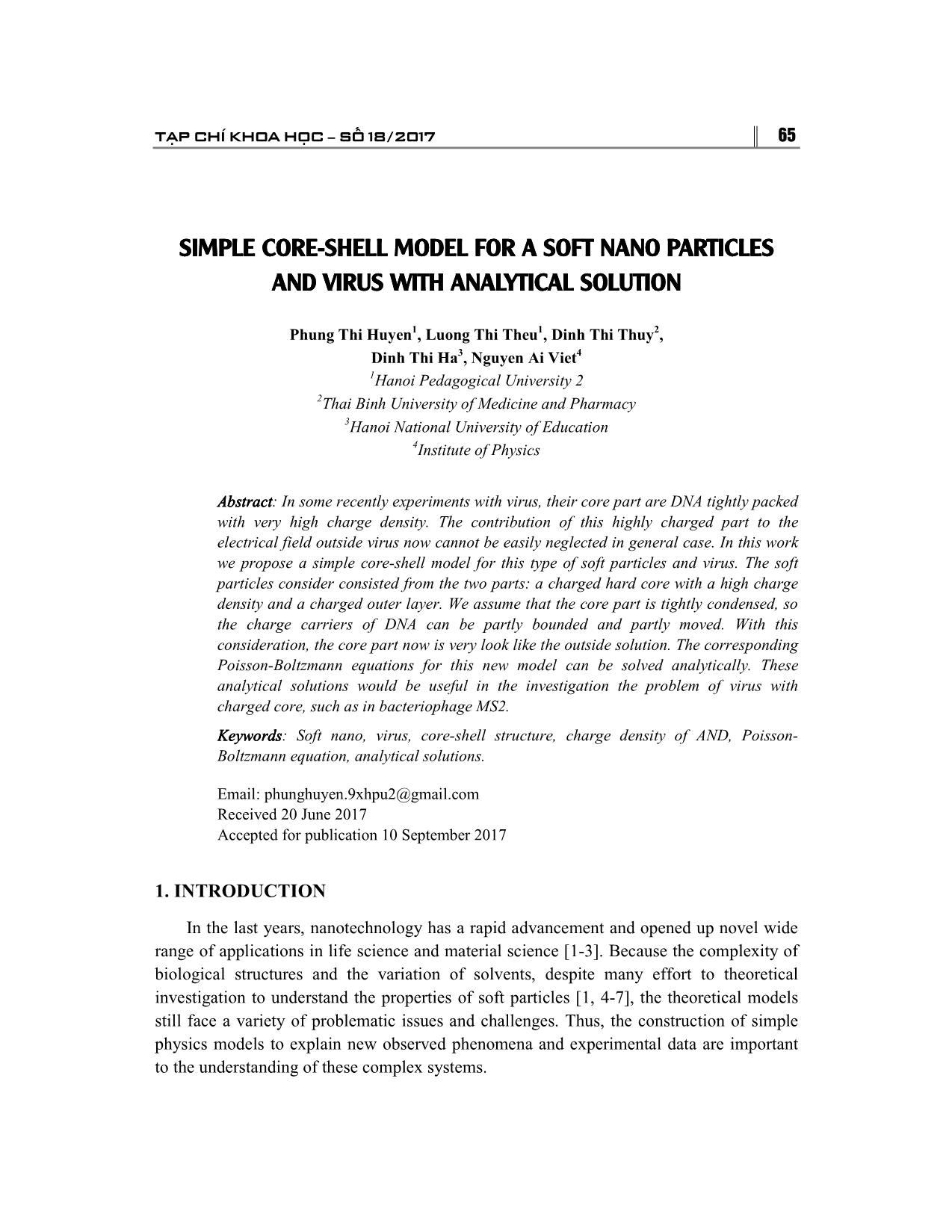
Trang 1
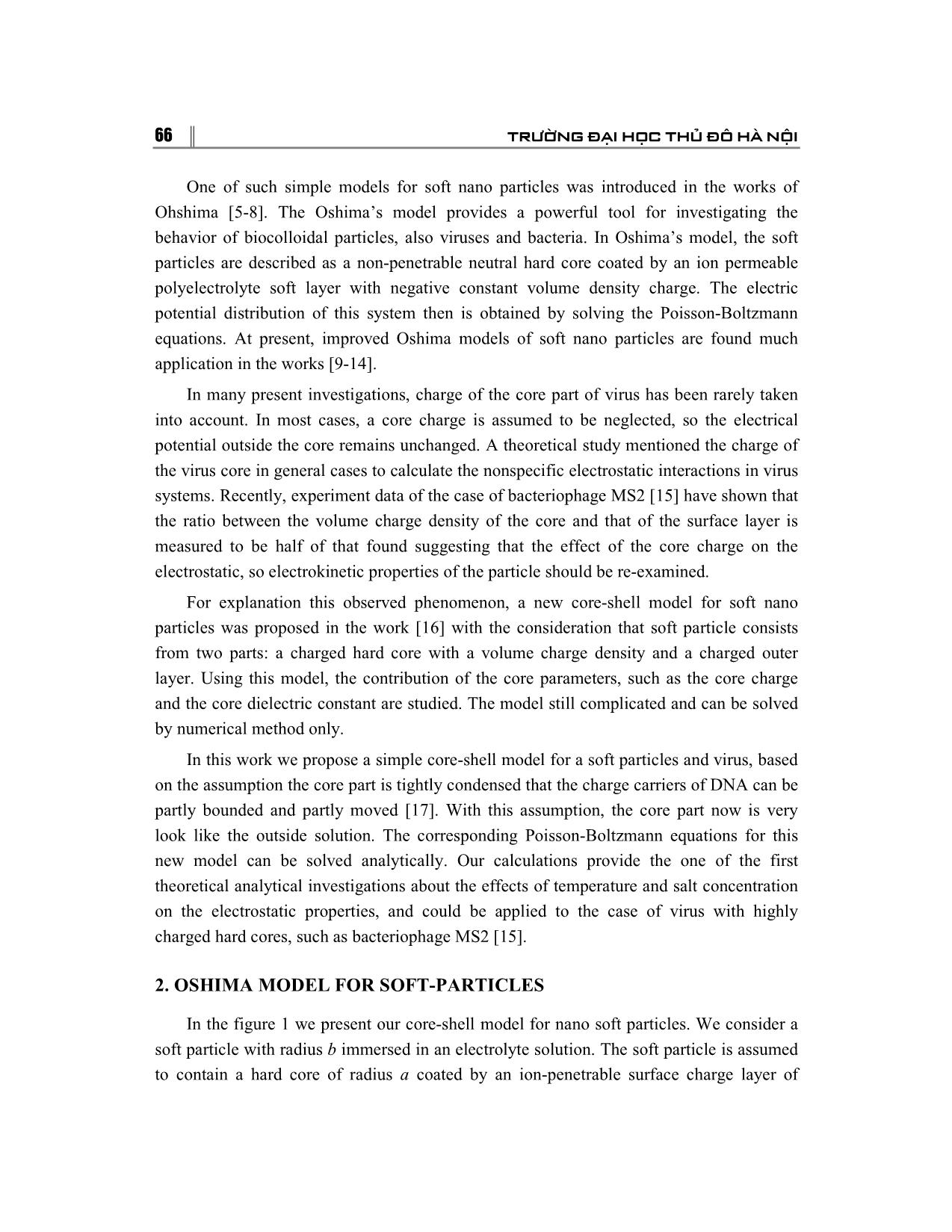
Trang 2
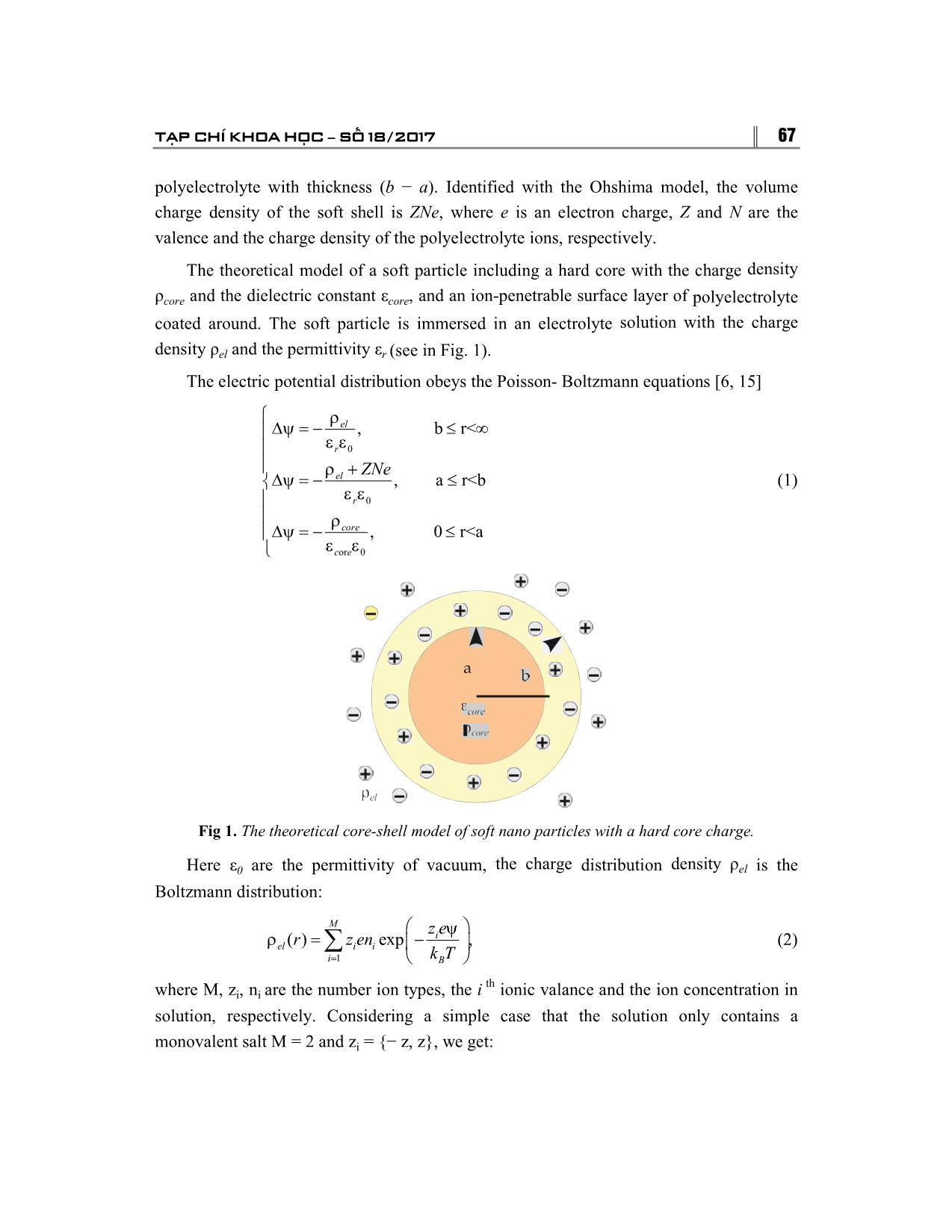
Trang 3
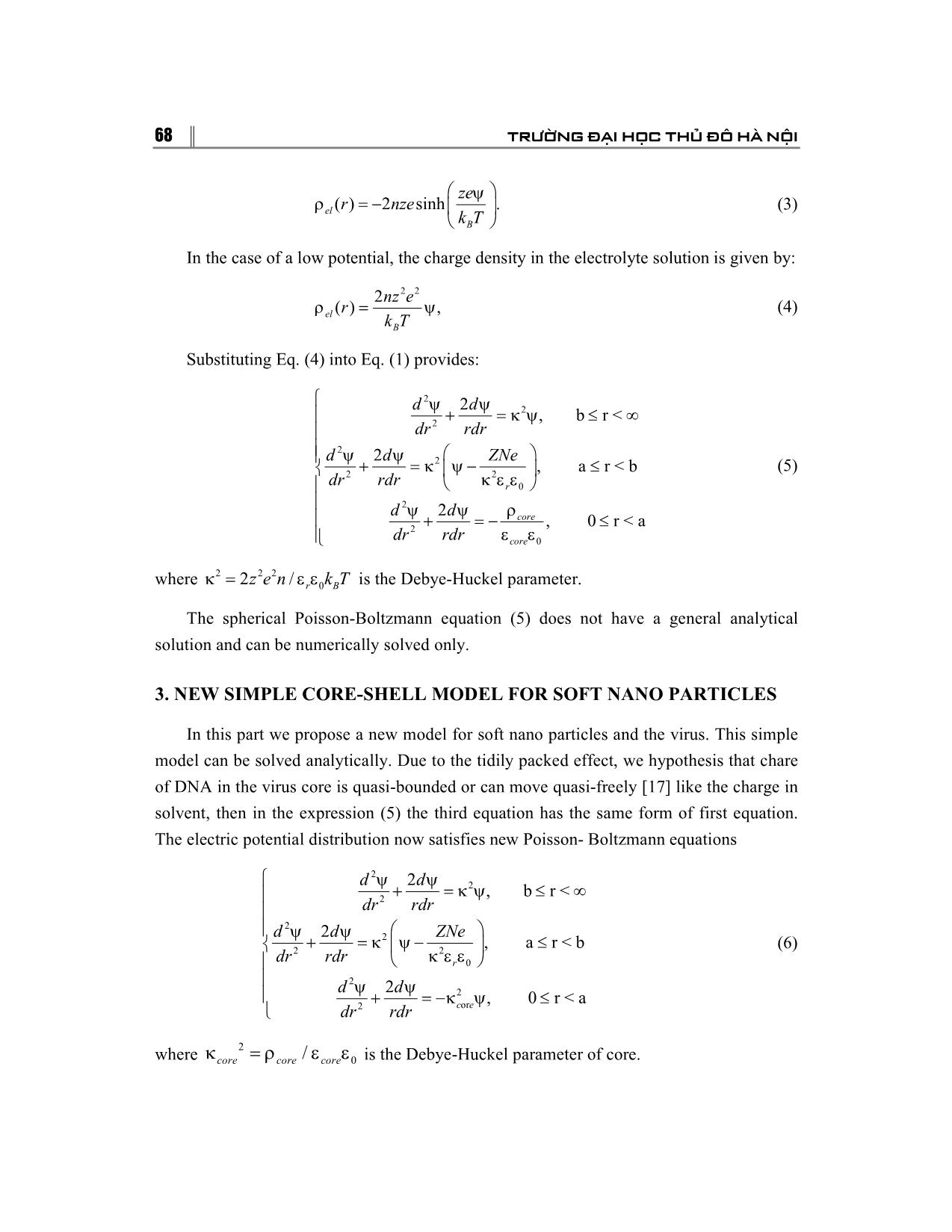
Trang 4
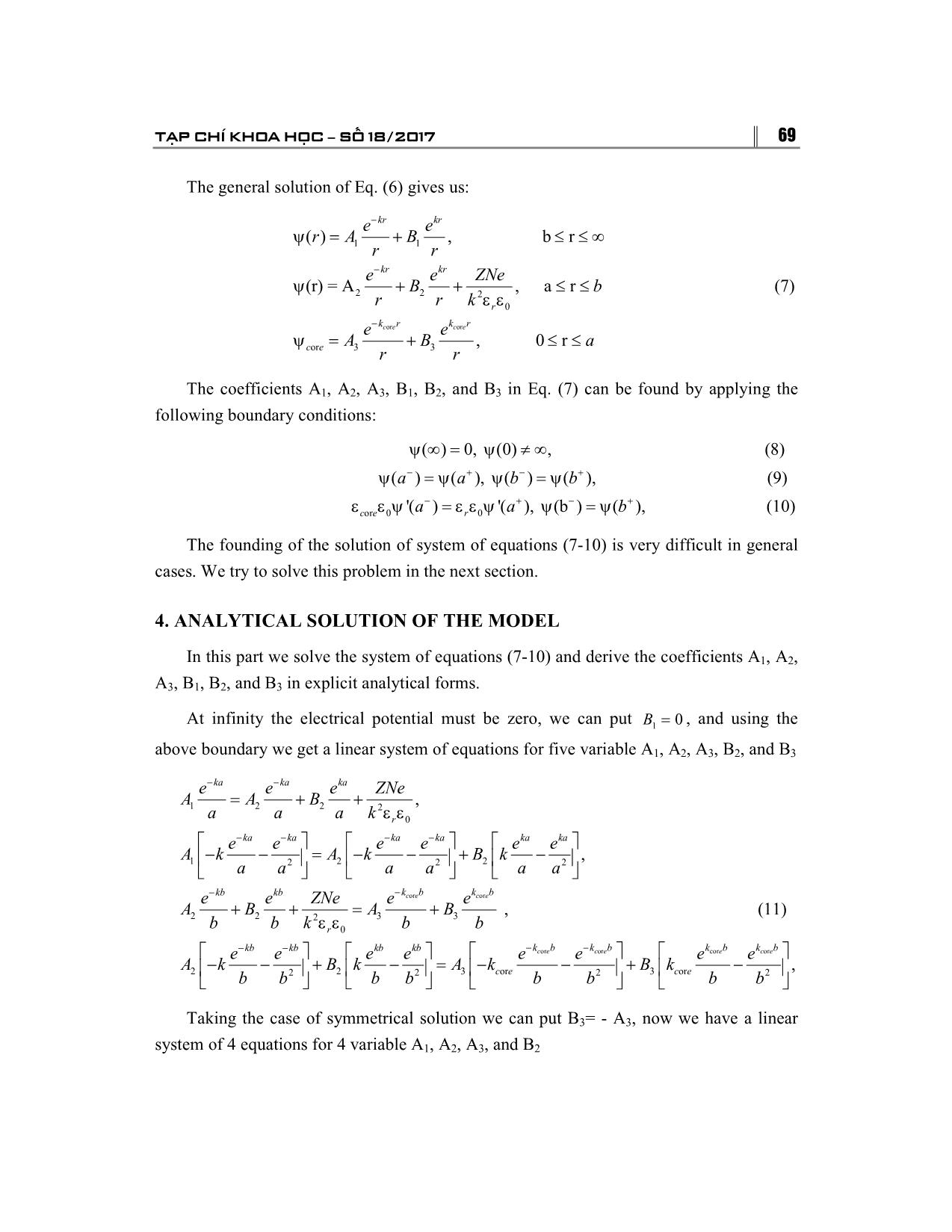
Trang 5
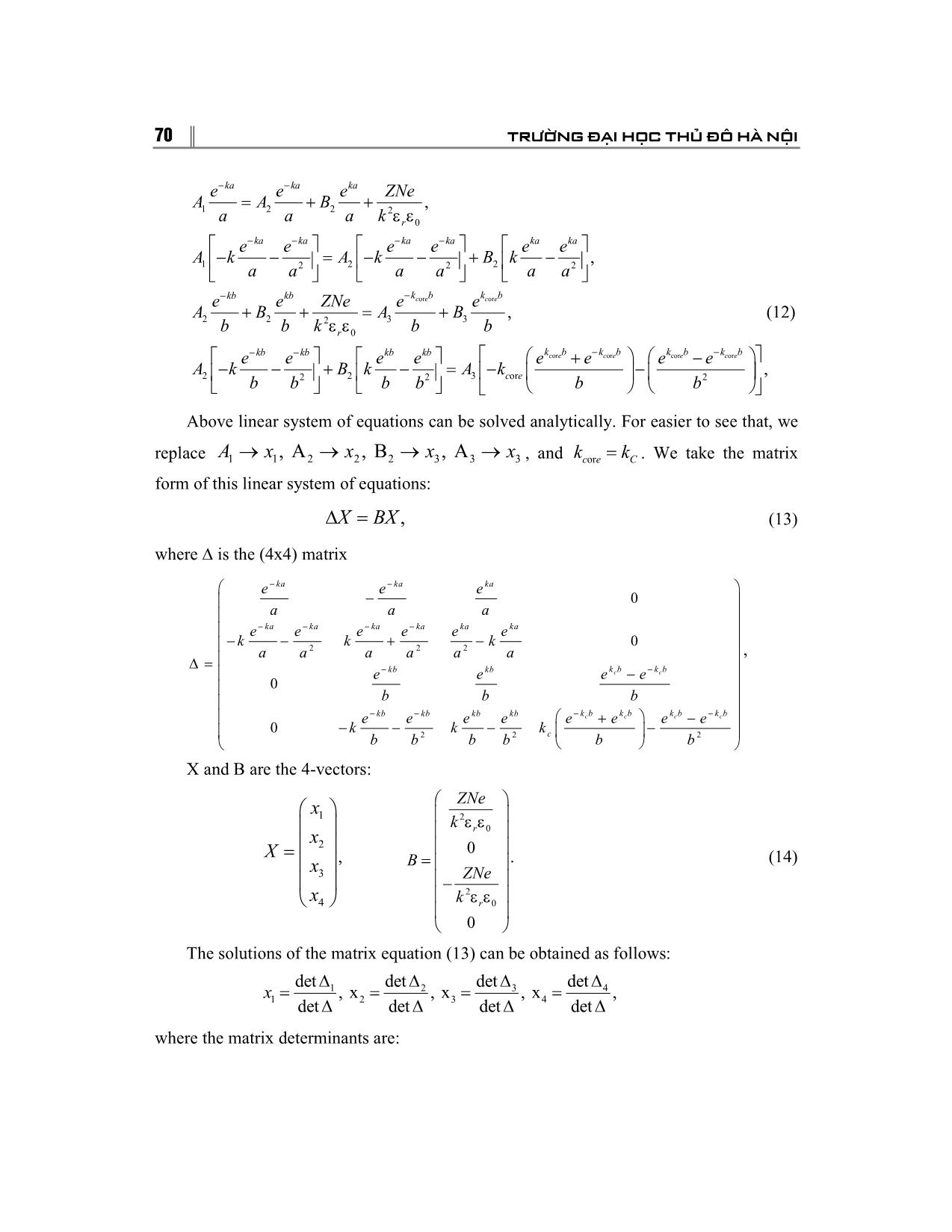
Trang 6
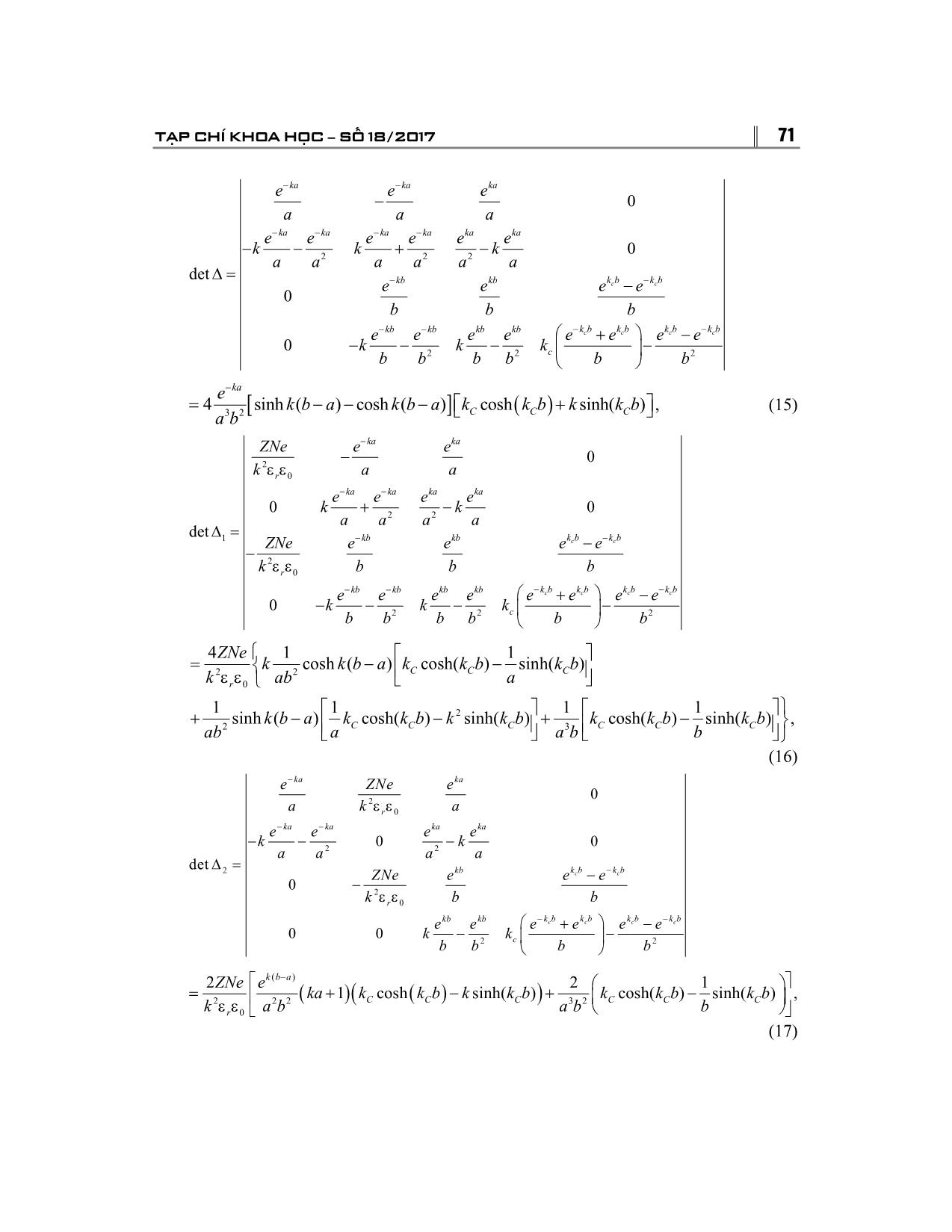
Trang 7
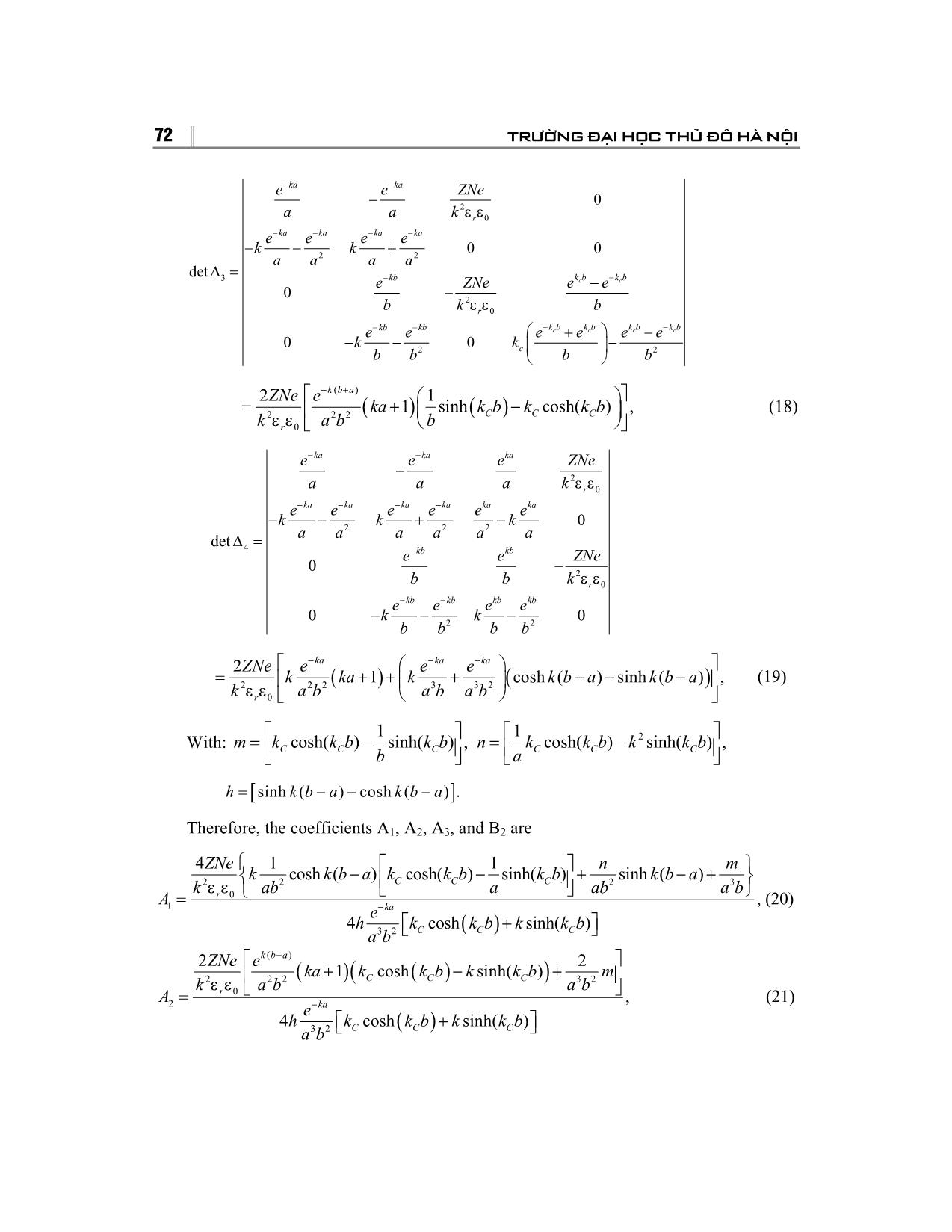
Trang 8
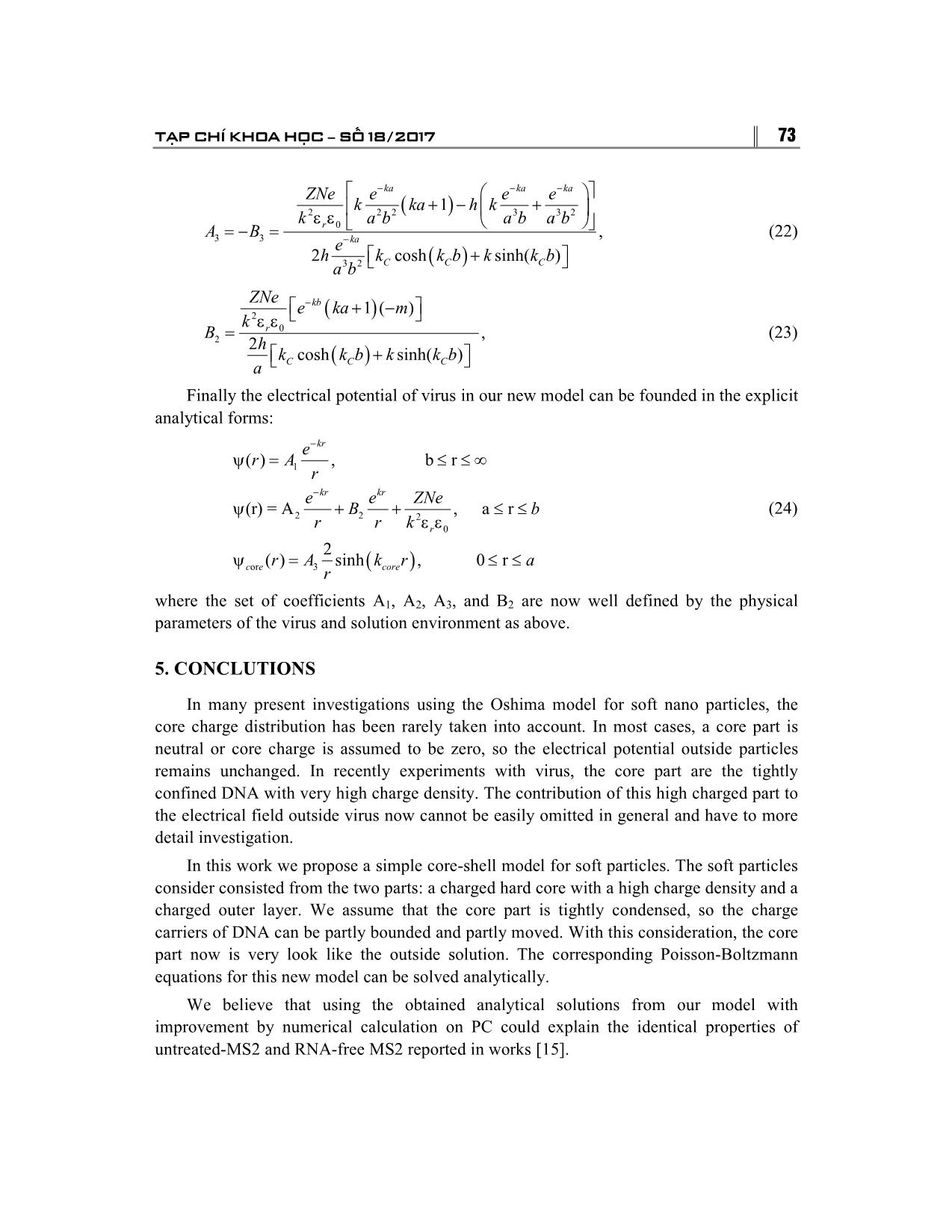
Trang 9
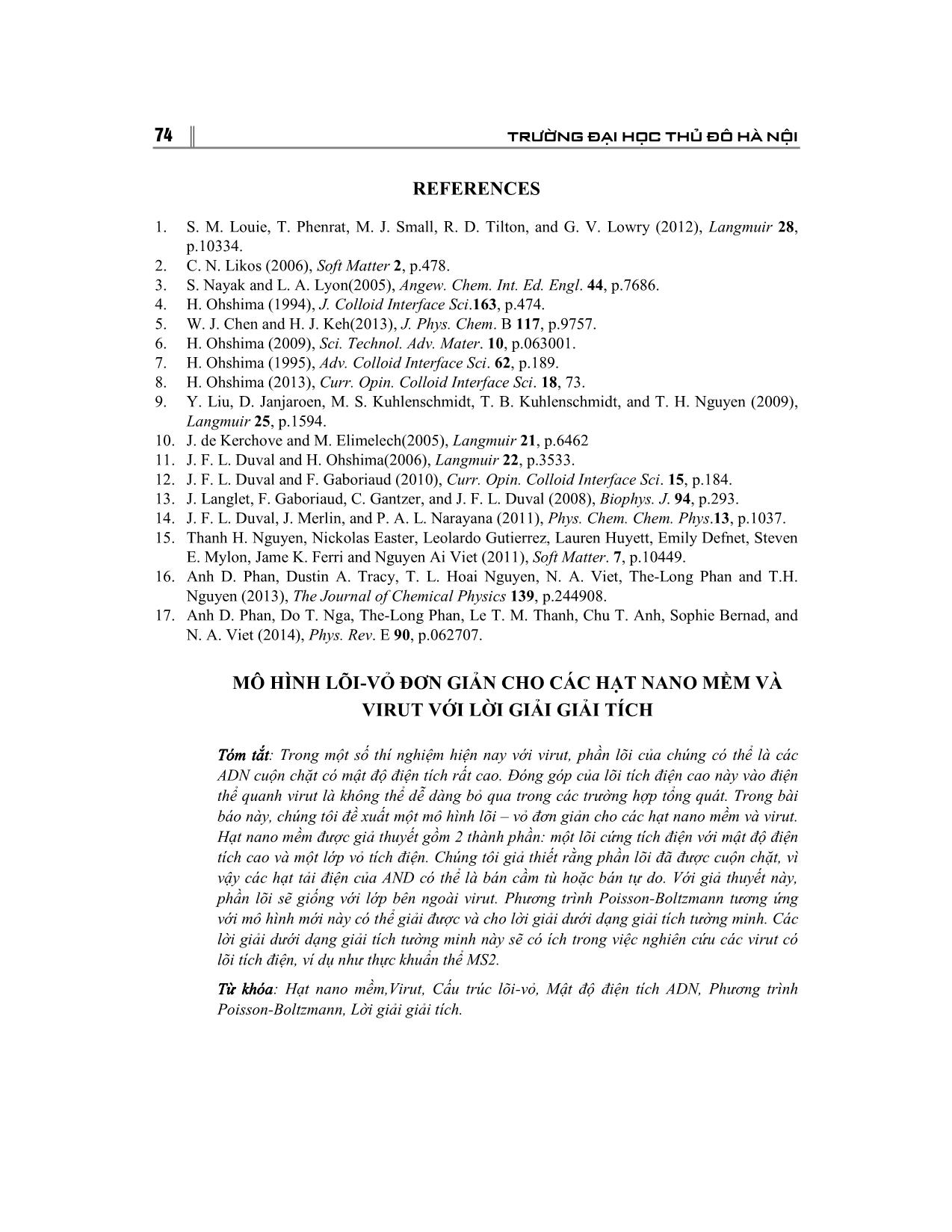
Trang 10
Tóm tắt nội dung tài liệu: Simple core-Shell model for a soft nano particles and virus with analytical solution
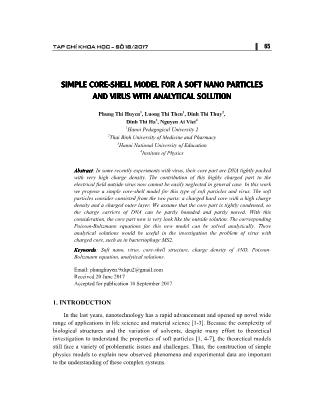
TP CH KHOA H
C − S
18/2017 65
SIMPLE CORE-SHELL MODEL FOR A SOFT NANO PARTICLES
AND VIRUS WITH ANALYTICAL SOLUTION
Phung Thi Huyen1, Luong Thi Theu1, Dinh Thi Thuy2,
Dinh Thi Ha3, Nguyen Ai Viet4
1Hanoi Pedagogical University 2
2Thai Binh University of Medicine and Pharmacy
3Hanoi National University of Education
4Institute of Physics
Abstract: In some recently experiments with virus, their core part are DNA tightly packed
with very high charge density. The contribution of this highly charged part to the
electrical field outside virus now cannot be easily neglected in general case. In this work
we propose a simple core-shell model for this type of soft particles and virus. The soft
particles consider consisted from the two parts: a charged hard core with a high charge
density and a charged outer layer. We assume that the core part is tightly condensed, so
the charge carriers of DNA can be partly bounded and partly moved. With this
consideration, the core part now is very look like the outside solution. The corresponding
Poisson-Boltzmann equations for this new model can be solved analytically. These
analytical solutions would be useful in the investigation the problem of virus with
charged core, such as in bacteriophage MS2.
Keywords: Soft nano, virus, core-shell structure, charge density of AND, Poisson-
Boltzmann equation, analytical solutions.
Email: phunghuyen.9xhpu2@gmail.com
Received 20 June 2017
Accepted for publication 10 September 2017
1. INTRODUCTION
In the last years, nanotechnology has a rapid advancement and opened up novel wide
range of applications in life science and material science [1-3]. Because the complexity of
biological structures and the variation of solvents, despite many effort to theoretical
investigation to understand the properties of soft particles [1, 4-7], the theoretical models
still face a variety of problematic issues and challenges. Thus, the construction of simple
physics models to explain new observed phenomena and experimental data are important
to the understanding of these complex systems.
66 TRNG I H
C TH
H
N I
One of such simple models for soft nano particles was introduced in the works of
Ohshima [5-8]. The Oshima’s model provides a powerful tool for investigating the
behavior of biocolloidal particles, also viruses and bacteria. In Oshima’s model, the soft
particles are described as a non-penetrable neutral hard core coated by an ion permeable
polyelectrolyte soft layer with negative constant volume density charge. The electric
potential distribution of this system then is obtained by solving the Poisson-Boltzmann
equations. At present, improved Oshima models of soft nano particles are found much
application in the works [9-14].
In many present investigations, charge of the core part of virus has been rarely taken
into account. In most cases, a core charge is assumed to be neglected, so the electrical
potential outside the core remains unchanged. A theoretical study mentioned the charge of
the virus core in general cases to calculate the nonspecific electrostatic interactions in virus
systems. Recently, experiment data of the case of bacteriophage MS2 [15] have shown that
the ratio between the volume charge density of the core and that of the surface layer is
measured to be half of that found suggesting that the effect of the core charge on the
electrostatic, so electrokinetic properties of the particle should be re-examined.
For explanation this observed phenomenon, a new core-shell model for soft nano
particles was proposed in the work [16] with the consideration that soft particle consists
from two parts: a charged hard core with a volume charge density and a charged outer
layer. Using this model, the contribution of the core parameters, such as the core charge
and the core dielectric constant are studied. The model still complicated and can be solved
by numerical method only.
In this work we propose a simple core-shell model for a soft particles and virus, based
on the assumption the core part is tightly condensed that the charge carriers of DNA can be
partly bounded and partly moved [17]. With this assumption, the core part now is very
look like the outside solution. The corresponding Poisson-Boltzmann equations for this
new model can be solved analytically. Our calculations provide the one of the first
theoretical analytical investigations about the effects of temperature and salt concentration
on the electrostatic properties, and could be applied to the case of virus with highly
charged hard cores, such as bacteriophage MS2 [15].
2. OSHIMA MODEL FOR SOFT-PARTICLES
In the figure 1 we present our core-shell model for nano soft particles. We consider a
soft particle with radius b immersed in an electrolyte solution. The soft particle is assumed
to contain a hard core of radius a coated by an ion-penetrable surface charge layer of
TP CH KHOA H
C − S
18/2017 67
polyelectrolyte with thickness (b − a). Identified with the Ohshima model, the volume
charge density of the soft shell is ZNe, where e is an electron charge, Z and N are the
valence and the charge density of the polyelectrolyte ions, respectively.
The theoretical model of a soft particle including a hard core with the charge density
ρcore and the dielectric constant εcore, and an ion-penetrable surface layer of polyelectrolyte
coated around. The soft particle is immersed in an electrolyte solution with the charge
density ρel and the permittivity εr (see in Fig. 1).
The electric potential distribution obeys the Poisson- Boltzmann equations [6, 15]
0
0
or 0
, b r<
, a r<b
, 0 r<a
el
r
el
r
core
c e
ZNe
ρ
∆ψ = − ≤ ∞ ε ε
ρ +
∆ψ = − ≤
ε ε
ρ
∆ψ = − ≤
ε ε
(1)
Fig 1. The theoretical core-shell model of soft nano particles with a hard core charge.
Here ε0 are the permittivity of vacuum, the charge distribution density ρel is the
Boltzmann distribution:
1
( ) exp ,
M
i
el i i
i B
z e
r z en
k T=
ψ
ρ = −
∑ (2)
where M, zi, ni are the number ion types, the i
th ionic valance and the ion concentration in
solution, respectively. Considering a simple case that the solution only contains a
monovalent salt M = 2 and zi = {− z, z}, we get:
68 TRNG I H
C TH
H
N I
( ) 2 sinh .el
B
ze
r nze
k T
ψ
ρ = −
(3)
In the case of a low potential, the charge density in the electrolyte solution is given by:
2 22
( ) ,el
B
nz e
r
k T
ρ = ψ (4)
Substituting Eq. (4) into Eq. (1) provides:
2
2
2
2
2
2 2
0
2
2
0
2
, b r <
2
, a r < b (5)
2
, 0 r < a
r
core
core
d d
dr rdr
d d ZNe
dr rdr
d d
dr rdr
ψ ψ
+ = κ ψ ≤ ∞
ψ ψ
+ = κ ψ − ≤ κ ε ε
ψ ψ ρ + = − ≤
ε ε
(5)
where 2 2 2 02 / r Bz e n k Tκ = ε ε is the Debye-Huckel parameter.
The spherical Poisson-Boltzmann equation (5) does not have a general analytical
solution and can be numerically solved only.
3. NEW SIMPLE CORE-SHELL MODEL FOR SOFT NANO PARTICLES
In this part we propose a new model for soft nano particles and the virus. This simple
model can be solved analytically. Due to the tidily packed effect, we hypothesis that chare
of DNA in the virus core is quasi-bounded or can move quasi-freely [17] like the charge in
solvent, then in the expression (5) the third equation has the same form of first equation.
The electric potential distribution now satisfies new Poisson- Boltzmann equations
2
2
2
2
2
2 2
0
2
2
or2
2
, b r <
2
, a r < b (6)
2
, 0 r < a
r
c e
d d
dr rdr
d d ZNe
dr rdr
d d
dr rdr
ψ ψ
+ = κ ψ ≤ ∞
ψ ψ
+ = κ ψ − ≤
κ ε ε
ψ ψ + = −κ ψ ≤
(6)
where 2 0/core core coreκ = ρ ε ε is the Debye-Huckel parameter of core.
TP CH KHOA H
C − S
18/2017 69
The general solution of Eq. (6) gives us:
or or
1 1
2 2 2
0
or 3 3
( ) , b r
(r) = A , a r (7)
, 0 r
c e c e
kr kr
kr kr
r
k r k r
c e
e e
r A B
r r
e e ZNe
B b
r r k
e e
A B a
r r
−
−
−
ψ = + ≤ ≤ ∞
ψ + + ≤ ≤
ε ε
ψ = + ≤ ≤
The coefficients A1, A2, A3, B1, B2, and B3 in Eq. (7) can be found by applying the
following boundary conditions:
or 0 0
( ) 0, (0) , (8)
( ) ( ), ( ) ( ), (9)
'( ) '( ), (b ) ( ), c e r
a a b b
a a b
− + − +
− + − +
ψ ∞ = ψ ≠ ∞
ψ = ψ ψ = ψ
ε ε ψ = ε ε ψ ψ = ψ (10)
The founding of the solution of system of equations (7-10) is very difficult in general
cases. We try to solve this problem in the next section.
4. ANALYTICAL SOLUTION OF THE MODEL
In this part we solve the system of equations (7-10) and derive the coefficients A1, A2,
A3, B1, B2, and B3 in explicit analytical forms.
At infinity the electrical potential must be zero, we can put 1 0B = , and using the
above boundary we get a linear system of equations for five variable A1, A2, A3, B2, and B3
or or
1 2 2 2
0
1 2 22 2 2
2 2 3 32
0
,
,
,
c e c e
ka ka ka
r
ka ka ka ka ka ka
k b k bkb kb
r
e e e ZNe
A A B
a a a k
e e e e e e
A k A k B k
a a a a a a
e e ZNe e e
A B A B
b b k b b
− −
− − − −
−−
= + +
ε ε
− − = − − + −
+ + = +
ε ε
or or cor or
2 2 3 or 3 or2 2 2 2
(11)
,
c e c e e c ek b k b k b k bkb kb kb kb
c e c e
e e e e e e e e
A k B k A k B k
b b b b b b b b
− −− −
− − + − = − − + −
Taking the case of symmetrical solution we can put B3= - A3, now we have a linear
system of 4 equations for 4 variable A1, A2, A3, and B2
70 TRNG I H
C TH
H
N I
or or
1 2 2 2
0
1 2 22 2 2
2 2 3 32
0
,
,
,
c e c e
ka ka ka
r
ka ka ka ka ka ka
k b k bkb kb
r
e e e ZNe
A A B
a a a k
e e e e e e
A k A k B k
a a a a a a
e e ZNe e e
A B A B
b b k b b
− −
− − − −
−−
= + +
ε ε
− − = − − + −
+ + = +
ε ε
or or cor or
2 2 3 or2 2 2
(12)
,
c e c e e c ek b k b k b k bkb kb kb kb
c e
e e e e e e e e
A k B k A k
b b b b b b
− −− − + −
− − + − = − −
Above linear system of equations can be solved analytically. For easier to see that, we
replace 1 1 2 2 2 3 3 3, A , B , AA x x x x→ → → → , and orc e Ck k= . We take the matrix
form of this linear system of equations:
,X BX∆ = (13)
where ∆ is the (4x4) matrix
2 2 2
2 2 2
0
0
0
0
c c
c c c c
ka ka ka
ka ka ka ka ka ka
k b k bkb kb
k b k b k b k bkb kb kb kb
c
e e e
a a a
e e e e e e
k k k
a a a a a a
e e e e
b b b
e e e e e e e e
k k k
b b b b b b
− −
− − − −
−−
− −− −
−
− − + −
∆ =
−
+ −
− − − −
,
X and B are the 4-vectors:
1
2
3
4
x
x
X
x
x
=
,
2
0
2
0
0
0
r
r
ZNe
k
B
ZNe
k
ε ε
=
−
ε ε
. (14)
The solutions of the matrix equation (13) can be obtained as follows:
1 2 3 41 2 3 4
det det det det
, x , x , x ,
det det det det
x
∆ ∆ ∆ ∆
= = = =
∆ ∆ ∆ ∆
where the matrix determinants are:
TP CH KHOA H
C − S
18/2017 71
2 2 2
2 2 2
0
0
det
0
0
c c
c c c c
ka ka ka
ka ka ka ka ka ka
k b k bkb kb
k b k b k b k bkb kb kb kb
c
e e e
a a a
e e e e e e
k k k
a a a a a a
e e e e
b b b
e e e e e e e e
k k k
b b b b b b
− −
− − − −
−−
− −− −
−
− − + −
∆ =
−
+ −
− − − −
[ ] ( )3 24 sinh ( ) cosh ( ) cosh sinh( ) ,
ka
C C C
e
k b a k b a k k b k k b
a b
−
= − − − + (15)
2
0
2 2
1
2
0
2 2 2
0
0 0
det
0
c c
c c c c
ka ka
r
ka ka ka ka
k b k bkb kb
r
k b k b k b k bkb kb kb kb
c
ZNe e e
k a a
e e e e
k k
a a a a
ZNe e e e e
k b b b
e e e e e e e e
k k k
b b b b b b
−
− −
−−
− −− −
−
ε ε
+ −
∆ =
−
−
ε ε
+ −
− − − −
2 2
0
2
2 3
4 1 1
cosh ( ) cosh( ) sinh( )
1 1 1 1
sinh ( ) cosh( ) sinh( ) cosh( ) sinh( ) ,
C C C
r
C C C C C C
ZNe
k k b a k k b k b
k ab a
k b a k k b k k b k k b k b
ab a a b b
= − − ε ε
+ − − + −
(16)
2
0
2 2
2
2
0
2 2
0
0 0
det
0
0 0
c c
c c c c
ka ka
r
ka ka ka ka
k b k bkb
r
k b k b k b k bkb kb
c
e ZNe e
a k a
e e e e
k k
a a a a
ZNe e e e
k b b
e e e e e e
k k
b b b b
−
− −
−
− −
ε ε
− − −
∆ =
−
−
ε ε
+ −
− −
( ) ( )( )
( )
2 2 2 3 2
0
2 2 1
1 cosh sinh( ) cosh( ) sinh( ) ,
k b a
C C C C C C
r
ZNe e
ka k k b k k b k k b k b
k a b a b b
− = + − + − ε ε
(17)
72 TRNG I H
C TH
H
N I
2
0
2 2
3
2
0
2 2
0
0 0
det
0
0 0
c c
c c c c
ka ka
r
ka ka ka ka
k b k bkb
r
k b k b k b k bkb kb
c
e e ZNe
a a k
e e e e
k k
a a a a
e ZNe e e
b k b
e e e e e e
k k
b b b b
− −
− − − −
−−
− −− −
−
ε ε
− − +
∆ =
−
−
ε ε
+ −
− − −
( ) ( )
( )
2 2 2
0
2 1
1 sinh cosh( ) ,
k b a
C C C
r
ZNe e
ka k b k k b
k a b b
− + = + − ε ε
(18)
2
0
2 2 2
4
2
0
2 2
0
det
0
0 0
ka ka ka
r
ka ka ka ka ka ka
kb kb
r
kb kb kb kb
e e e ZNe
a a a k
e e e e e e
k k k
a a a a a a
e e ZNe
b b k
e e e e
k k
b b b b
− −
− − − −
−
− −
−
ε ε
− − + −
∆ =
−
ε ε
− − −
( ) ( )2 2 2 3 3 2
0
2
1 cosh ( ) sinh ( ) ,
ka ka ka
r
ZNe e e e
k ka k k b a k b a
k a b a b a b
− − −
= + + + − − − ε ε
(19)
With:
1
cosh( ) sinh( ) ,C C Cm k k b k bb
= −
21 cosh( ) sinh( ) ,C C Cn k k b k k ba
= −
[ ]sinh ( ) cosh ( ) .h k b a k b a= − − −
Therefore, the coefficients A1, A2, A3, and B2 are
( )
2 2 2 3
0
1
3 2
4 1 1
cosh ( ) cosh( ) sinh( ) sinh ( )
, (20)
4 cosh sinh( )
−
− − + − + ε ε =
+
C C C
r
ka
C C C
ZNe n m
k k b a k k b k b k b a
k ab a ab a b
A
e
h k k b k k b
a b
( ) ( )( )
( )
( )
2 2 2 3 2
0
2
3 2
2 2
1 cosh sinh( )
, (21)
4 cosh sinh( )
−
−
+ − + ε ε =
+
k b a
C C C
r
ka
C C C
ZNe e
ka k k b k k b m
k a b a b
A
e
h k k b k k b
a b
TP CH KHOA H
C − S
18/2017 73
( )
( )
2 2 2 3 3 2
0
3 3
3 2
1
,
2 cosh sinh( )
− − −
−
+ − + ε ε = − =
+
ka ka ka
r
ka
C C C
ZNe e e e
k ka h k
k a b a b a b
A B
e
h k k b k k b
a b
(22)
( )
( )
2
0
2
1 ( )
,
2
cosh sinh( )
− + − ε ε
=
+
kb
r
C C C
ZNe
e ka m
k
B
h
k k b k k b
a
(23)
Finally the electrical potential of virus in our new model can be founded in the explicit
analytical forms:
( )
1
2 2 2
0
or 3
( ) , b r
(r) = A , a r (24)
2
( ) sinh , 0 r
kr
kr kr
r
c e core
e
r A
r
e e ZNe
B b
r r k
r A k r a
r
−
−
ψ = ≤ ≤ ∞
ψ + + ≤ ≤
ε ε
ψ = ≤ ≤
(24)
where the set of coefficients A1, A2, A3, and B2 are now well defined by the physical
parameters of the virus and solution environment as above.
5. CONCLUTIONS
In many present investigations using the Oshima model for soft nano particles, the
core charge distribution has been rarely taken into account. In most cases, a core part is
neutral or core charge is assumed to be zero, so the electrical potential outside particles
remains unchanged. In recently experiments with virus, the core part are the tightly
confined DNA with very high charge density. The contribution of this high charged part to
the electrical field outside virus now cannot be easily omitted in general and have to more
detail investigation.
In this work we propose a simple core-shell model for soft particles. The soft particles
consider consisted from the two parts: a charged hard core with a high charge density and a
charged outer layer. We assume that the core part is tightly condensed, so the charge
carriers of DNA can be partly bounded and partly moved. With this consideration, the core
part now is very look like the outside solution. The corresponding Poisson-Boltzmann
equations for this new model can be solved analytically.
We believe that using the obtained analytical solutions from our model with
improvement by numerical calculation on PC could explain the identical properties of
untreated-MS2 and RNA-free MS2 reported in works [15].
74 TRNG I H
C TH
H
N I
REFERENCES
1. S. M. Louie, T. Phenrat, M. J. Small, R. D. Tilton, and G. V. Lowry (2012), Langmuir 28,
p.10334.
2. C. N. Likos (2006), Soft Matter 2, p.478.
3. S. Nayak and L. A. Lyon(2005), Angew. Chem. Int. Ed. Engl. 44, p.7686.
4. H. Ohshima (1994), J. Colloid Interface Sci.163, p.474.
5. W. J. Chen and H. J. Keh(2013), J. Phys. Chem. B 117, p.9757.
6. H. Ohshima (2009), Sci. Technol. Adv. Mater. 10, p.063001.
7. H. Ohshima (1995), Adv. Colloid Interface Sci. 62, p.189.
8. H. Ohshima (2013), Curr. Opin. Colloid Interface Sci. 18, 73.
9. Y. Liu, D. Janjaroen, M. S. Kuhlenschmidt, T. B. Kuhlenschmidt, and T. H. Nguyen (2009),
Langmuir 25, p.1594.
10. J. de Kerchove and M. Elimelech(2005), Langmuir 21, p.6462
11. J. F. L. Duval and H. Ohshima(2006), Langmuir 22, p.3533.
12. J. F. L. Duval and F. Gaboriaud (2010), Curr. Opin. Colloid Interface Sci. 15, p.184.
13. J. Langlet, F. Gaboriaud, C. Gantzer, and J. F. L. Duval (2008), Biophys. J. 94, p.293.
14. J. F. L. Duval, J. Merlin, and P. A. L. Narayana (2011), Phys. Chem. Chem. Phys.13, p.1037.
15. Thanh H. Nguyen, Nickolas Easter, Leolardo Gutierrez, Lauren Huyett, Emily Defnet, Steven
E. Mylon, Jame K. Ferri and Nguyen Ai Viet (2011), Soft Matter. 7, p.10449.
16. Anh D. Phan, Dustin A. Tracy, T. L. Hoai Nguyen, N. A. Viet, The-Long Phan and T.H.
Nguyen (2013), The Journal of Chemical Physics 139, p.244908.
17. Anh D. Phan, Do T. Nga, The-Long Phan, Le T. M. Thanh, Chu T. Anh, Sophie Bernad, and
N. A. Viet (2014), Phys. Rev. E 90, p.062707.
MÔ HÌNH LÕI-VỎ ĐƠN GIẢN CHO CÁC HẠT NANO MỀM VÀ
VIRUT VỚI LỜI GIẢI GIẢI TÍCH
Tóm tắt: Trong một số thí nghiệm hiện nay với virut, phần lõi của chúng có thể là các
ADN cuộn chặt có mật độ điện tích rất cao. Đóng góp của lõi tích điện cao này vào điện
thể quanh virut là không thể dễ dàng bỏ qua trong các trường hợp tổng quát. Trong bài
báo này, chúng tôi đề xuất một mô hình lõi – vỏ đơn giản cho các hạt nano mềm và virut.
Hạt nano mềm được giả thuyết gồm 2 thành phần: một lõi cứng tích điện với mật độ điện
tích cao và một lớp vỏ tích điện. Chúng tôi giả thiết rằng phần lõi đã được cuộn chặt, vì
vậy các hạt tải điện của AND có thể là bán cầm tù hoặc bán tự do. Với giả thuyết này,
phần lõi sẽ giống với lớp bên ngoài virut. Phương trình Poisson-Boltzmann tương ứng
với mô hình mới này có thể giải được và cho lời giải dưới dạng giải tích tường minh. Các
lời giải dưới dạng giải tích tường minh này sẽ có ích trong việc nghiên cứu các virut có
lõi tích điện, ví dụ như thực khuẩn thể MS2.
Từ khóa: Hạt nano mềm,Virut, Cấu trúc lõi-vỏ, Mật độ điện tích ADN, Phương trình
Poisson-Boltzmann, Lời giải giải tích.
File đính kèm:
 simple_core_shell_model_for_a_soft_nano_particles_and_virus.pdf
simple_core_shell_model_for_a_soft_nano_particles_and_virus.pdf

